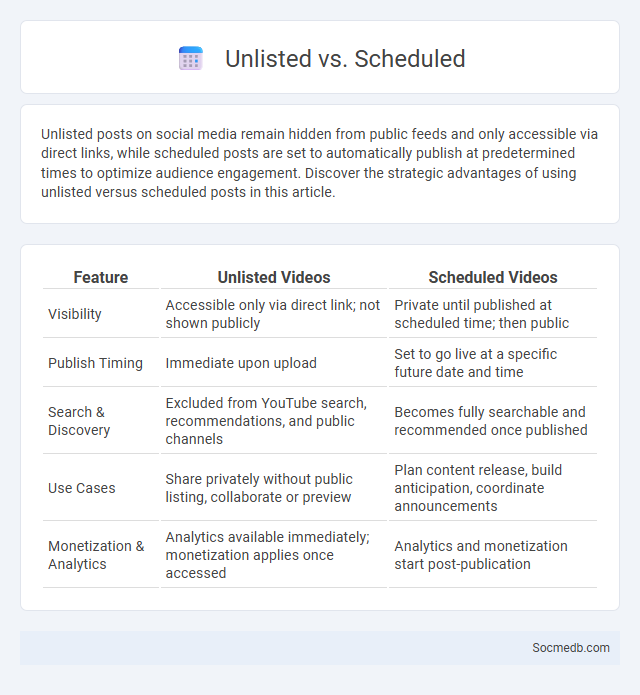
Photo illustration: Unlisted vs Scheduled
Unlisted posts on social media remain hidden from public feeds and only accessible via direct links, while scheduled posts are set to automatically publish at predetermined times to optimize audience engagement. Discover the strategic advantages of using unlisted versus scheduled posts in this article.
Table of Comparison
| Feature | Unlisted Videos | Scheduled Videos |
|---|---|---|
| Visibility | Accessible only via direct link; not shown publicly | Private until published at scheduled time; then public |
| Publish Timing | Immediate upon upload | Set to go live at a specific future date and time |
| Search & Discovery | Excluded from YouTube search, recommendations, and public channels | Becomes fully searchable and recommended once published |
| Use Cases | Share privately without public listing, collaborate or preview | Plan content release, build anticipation, coordinate announcements |
| Monetization & Analytics | Analytics available immediately; monetization applies once accessed | Analytics and monetization start post-publication |
Understanding Video Privacy Settings
Video privacy settings on social media platforms control who can view, comment on, and share your content, allowing users to tailor their audience from public to private or custom lists. Platforms like Facebook, Instagram, and YouTube provide options such as "Public," "Friends," "Only Me," and "Custom," enabling precise control over video visibility and engagement. Understanding these settings helps protect personal information, manage digital footprints, and maintain control over who accesses sensitive or personal videos.
What is an Unlisted Video?
An unlisted video on social media platforms like YouTube is a video that does not appear in search results, your channel, or subscriber feeds, making it accessible only via a direct link. This privacy setting allows you to share content selectively without making it fully public, ideal for private sharing or limited audience engagement. Using unlisted videos can enhance your content strategy by controlling who views your media while maintaining easy sharing options.
Defining Scheduled Videos
Scheduled videos on social media refer to pre-recorded content set to publish automatically at a specific date and time across platforms like Facebook, YouTube, and Instagram. This feature enhances content planning and consistency, allowing marketers and creators to maintain audience engagement without manual posting. Leveraging scheduled videos boosts reach by aligning releases with peak user activity times, maximizing visibility and interaction.
Overview of Listed (Public) Videos
Listed or public videos on social media platforms are accessible to all users, enhancing visibility and engagement through broader audience reach. These videos often include metadata such as titles, descriptions, and tags, which play a crucial role in search engine optimization (SEO) and content discoverability. Analytics tools provide insights on viewer demographics, watch time, and interaction rates, helping creators optimize their content strategy.
Key Differences: Unlisted vs Scheduled vs Listed
Unlisted social media posts remain hidden from public feeds, accessible only via direct link, ensuring controlled audience reach and privacy. Scheduled posts are pre-planned content set to publish at specific times, enhancing consistent engagement and optimal timing without immediate visibility. Listed posts are publicly available on user profiles and feeds, maximizing exposure, discoverability, and interaction within the social media platform's ecosystem.
Pros and Cons of Unlisted Videos
Unlisted videos on social media platforms like YouTube offer privacy by restricting access to viewers with the direct link, allowing content sharing without public exposure. Your content remains searchable only if you share the URL, preventing unwanted comments or visibility but limiting organic reach and discoverability. This balance supports targeted audience engagement while sacrificing broader promotional opportunities inherent to public videos.
Advantages and Limitations of Scheduled Videos
Scheduled videos on social media platforms enable content creators to maintain consistent posting times, maximizing audience engagement and reach by aligning with peak user activity. This strategic timing enhances brand visibility and allows for efficient content management, saving valuable time and resources. However, limitations include reduced spontaneity and potential audience disconnect if trends or events rapidly change, making scheduled content appear outdated or irrelevant.
When to Use Each Video Privacy Option
Choosing the right video privacy option on social media depends on your content goals and audience. Public settings maximize reach, ideal for promotions or brand awareness, while Friends-only ensures sharing with trusted connections for personal moments. Selecting Private shields content from everyone but yourself, perfect for drafts or sensitive footage only You should access.
SEO Implications for Each Video Setting
Optimizing video settings on social media platforms significantly impacts SEO by enhancing visibility and engagement metrics crucial for ranking. Metadata such as titles, descriptions, and tags should be tailored with relevant keywords to improve searchability and indexing by algorithms. Proper video resolution, thumbnail selection, and transcript inclusion further boost user experience and accessibility, directly influencing organic reach and search performance.
Best Practices for Managing Video Visibility
Maximize your video visibility on social media by optimizing titles, descriptions, and tags with relevant keywords that enhance searchability and engagement. Consistently post high-quality content during peak user activity times to reach a broader audience and maintain algorithmic favor. Engage actively with viewers through comments and shares to boost video ranking and foster a loyal community.
 socmedb.com
socmedb.com